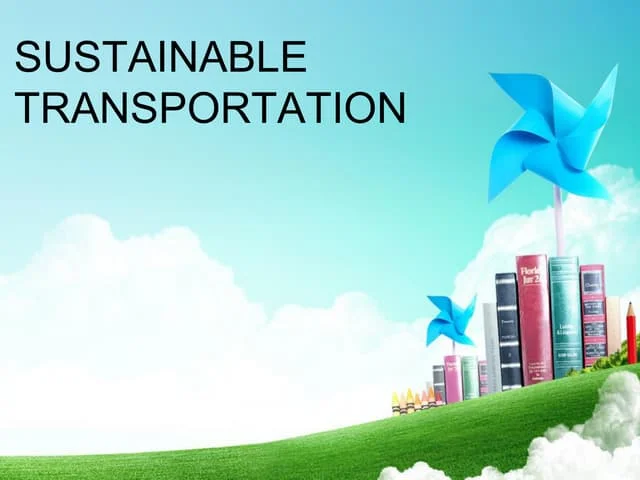Sustainable Transportation: Navigating Towards a Greener Future

In today’s rapidly evolving world, the need for sustainable transportation has become increasingly evident. As we face pressing environmental concerns such as climate change and air pollution, rethinking how we move people and goods has become imperative. Sustainable transportation encompasses a variety of modes and practices that aim to minimize environmental impact, promote economic efficiency, and enhance social equity.
Benefits of Sustainable Transportation
Environmental Impact
Sustainable transportation plays a crucial role in reducing greenhouse gas emissions and mitigating the effects of climate change. By transitioning to cleaner energy sources and promoting modes of transport with lower carbon footprints, such as walking, cycling, and public transit, we can significantly decrease air pollution and preserve natural resources.
Economic Advantages
Investing in sustainable transportation infrastructure can yield substantial economic benefits. Efficient public transportation systems reduce congestion, saving both time and money for commuters and businesses alike. Moreover, promoting alternative modes of transport can stimulate innovation and job creation in industries related to clean energy and transportation technology.
Social Benefits
Accessible and affordable transportation options are essential for fostering social inclusion and improving quality of life. Sustainable transportation initiatives aim to enhance mobility for all members of society, including those with limited access to private vehicles. By prioritizing pedestrian-friendly urban design and expanding public transit networks, we can create more vibrant and equitable communities.
Challenges in Implementing Sustainable Transportation
Despite its numerous benefits, implementing sustainable transportation initiatives often faces significant challenges.
Infrastructure Limitations
Building the necessary infrastructure for sustainable transportation, such as bike lanes, pedestrian walkways, and public transit systems, requires substantial investment and careful planning. In many cases, existing infrastructure may be inadequate or poorly maintained, hindering the adoption of alternative modes of transport.
Cultural and Behavioral Barriers
Shifting societal norms and behaviours towards more sustainable transportation choices can be challenging. Car-centric lifestyles and a reluctance to change entrenched habits pose barriers to promoting walking, cycling, and public transit use. Overcoming these cultural barriers requires targeted education and awareness campaigns, as well as incentives to encourage behaviour change.
Policy and Regulatory Challenges
Effective sustainable transportation policies require coordination among multiple stakeholders and levels of government. Conflicting interests and bureaucratic hurdles can impede progress and delay the implementation of vital infrastructure projects. Moreover, regulatory frameworks may need to be updated to accommodate emerging technologies and new transportation models.
Key Strategies for Promoting Sustainable Transportation
Addressing the challenges of sustainable transportation requires a multifaceted approach.
Investment in Public Transportation
Expanding and improving public transportation systems is crucial for reducing reliance on private vehicles and alleviating traffic congestion. Investments in high-speed rail, bus rapid transit, and other mass transit solutions can provide efficient and accessible alternatives to car travel.
Encouraging Active Transportation Modes
Promoting walking and cycling as viable modes of transport not only reduces emissions but also promotes public health and well-being. Creating safe and attractive walking and cycling routes, as well as providing amenities such as bike-sharing programs and secure bike parking, can encourage more people to choose active transportation options.
Integration of Technology
Advancements in technology have the potential to revolutionize sustainable transportation. From electric vehicles and renewable energy sources to smart traffic management systems and ride-sharing platforms, integrating technology into transportation infrastructure can improve efficiency, convenience, and safety.
Policy Initiatives and Incentives
Governments play a crucial role in shaping transportation policies and providing incentives for sustainable practices. Measures such as congestion pricing, fuel taxes, and subsidies for electric vehicles can help internalize the social and environmental costs of transportation and encourage more sustainable behaviour.
Case Studies: Successful Sustainable Transportation Initiatives
Several cities around the world have implemented innovative sustainable transport solutions with remarkable success.
Curitiba, Brazil
Curitiba’s bus rapid transit (BRT) system, known as the Rede Integrada de Transporte (Integrated Transport Network), has become a model for sustainable urban mobility. By prioritizing dedicated bus lanes, pre-board fare collection, and high-frequency service, Curitiba has achieved significant reductions in congestion and pollution.
Copenhagen, Denmark
Copenhagen is renowned for its extensive cycling infrastructure and commitment to promoting bike-friendly urban design. With over 400 kilometres of dedicated bike lanes and a culture that prioritizes cycling as a mode of transport, the city boasts one of the highest rates of bicycle commuting in the world.
Bogotá, Colombia
Bogotá’s TransMilenio BRT system has transformed the city’s transportation landscape, providing fast, reliable, and affordable transit options for millions of residents. By integrating BRT with pedestrian-friendly streetscapes and public spaces, Bogotá has created a more livable and sustainable urban environment.
Future Trends in Sustainable Transportation
Looking ahead, several trends are poised to shape the future of sustainable transportation.
Electric Vehicles
The widespread adoption of electric vehicles (EVs) has the potential to dramatically reduce emissions from the transportation sector. As battery technology continues to improve and charging infrastructure becomes more widespread, EVs are becoming increasingly viable alternatives to traditional gasoline-powered vehicles.
Shared Mobility Solutions
The rise of shared mobility services, such as ride-sharing, car-sharing, and bike-sharing, is transforming how people access transportation. By maximizing vehicle utilization and reducing the need for private car ownership, shared mobility solutions offer sustainable and cost-effective alternatives to traditional transportation modes.
Autonomous Transportation
Advancements in autonomous vehicle technology have the potential to revolutionize transportation systems, improving safety, efficiency, and accessibility. Autonomous vehicles have the potential to reduce traffic congestion, enhance mobility for elderly and disabled individuals, and optimize transportation networks through real-time data analysis and coordination.
Conclusion
Sustainable transport is not just a theoretical concept; it is a practical imperative for addressing the pressing challenges of our time. By prioritizing investments in public transit, promoting active transportation modes, harnessing the power of technology, and implementing forward-thinking policies, we can create a more sustainable and equitable transportation system for future generations.



Leave a Comment